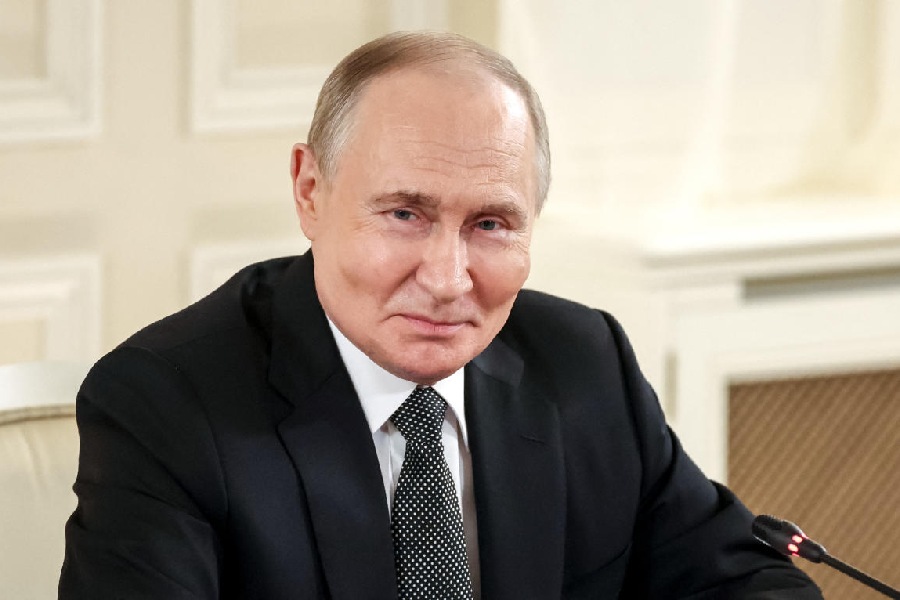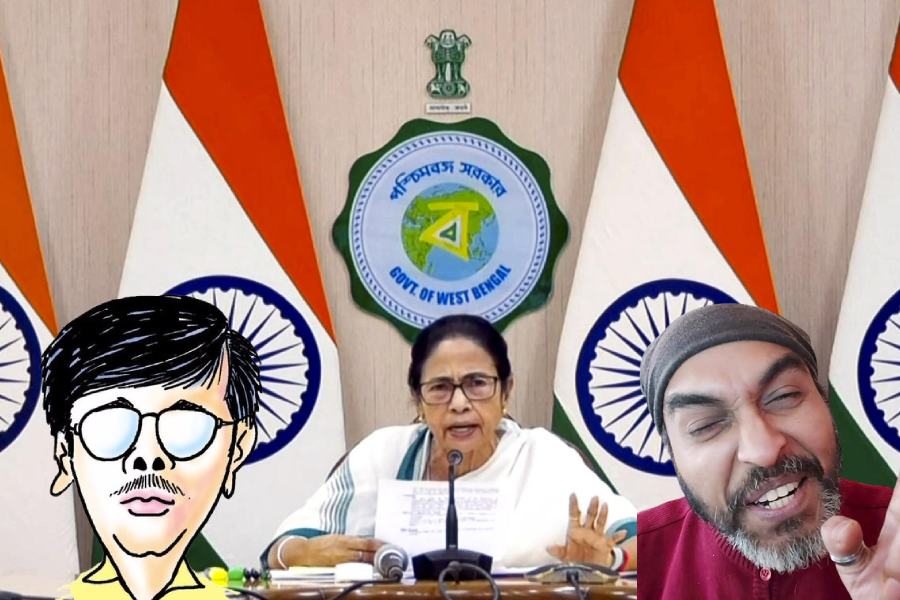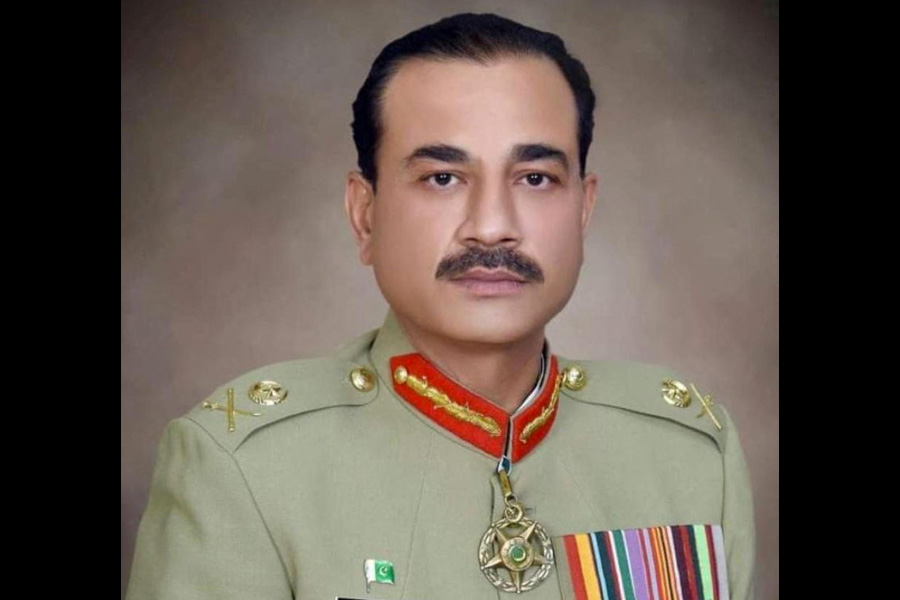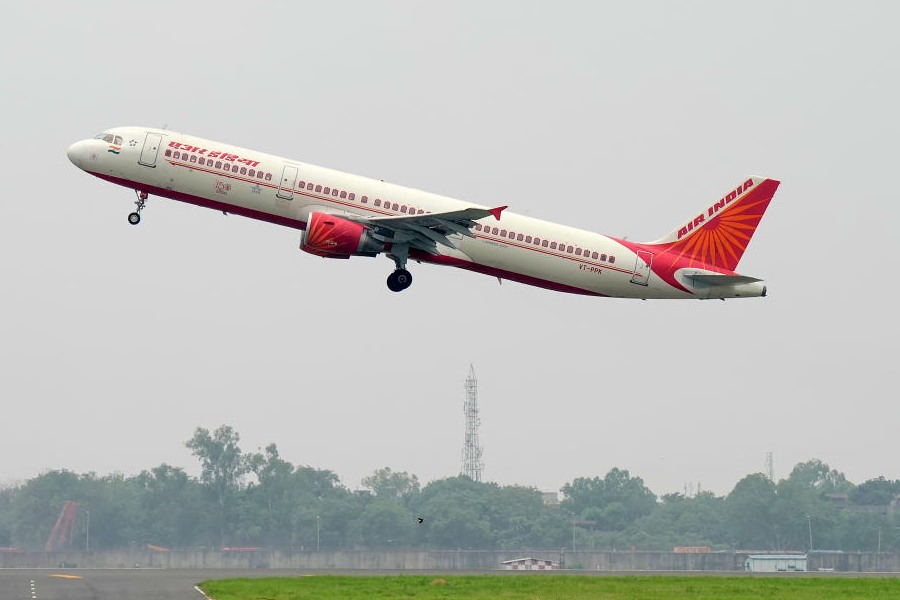 |
| A scene from the play Aaj Basanta staged at the Academy of Fine Arts on April 8. Designed and directed by Rajat Gangopadhyay, the play is set in the Sixties post the India-China war. It explores Bengal’s political scenario and the sentiments of people in that era. The central characters are a couple, Subinoy and Meera, who can’t realise their dreams as Subinoy fails to get a job. Picture by Arnab Mondal |
If Rabindranath’s birth anniversary is close at hand (May 9), how can books not be published to celebrate the occasion? Rabindranath Tagore and The Post Office: A Philatelic Tribute published recently by Rammohun Library & Free Reading Room and edited by Dipok Dey is an ingenious and rather unique way of remembering the poet. The title obviously refers to Tagore’s famous play, Dakghar, or post office. Dey, 76, is a well known collector and artist who is the only Indian to have designed a UN stamp, besides several other Indian stamps as well.
 |
| The cover of the book on Tagore edited by Dipok Dey |
The poet was felicitated at the library on February 1, 1914, after he was awarded the Nobel Prize, and this book is meant to commemorate that occasion. He was an indefatigable writer of letters having himself written more than 7,000 letters. As many as 22 countries on different occasions paid tribute to Tagore by issuing postage stamps. This book highlights almost all the stamps along with first day covers, first day postmarks, souvenir sheets, miniature sheets and selected special covers, special postmarks, booklets, max cards, picture postcards and catch covers. All of these come from Dey’s collection.
All the items are arranged alphabetically and it begins with Argentina with its associations with Victoria Ocampo. Next comes Bangladesh which first issued a stamp on Tagore’s 50th death anniversary. Several others follow from Bangladesh, the last being a first day cover issued in 2011. Its national anthem was after all written by the poet. Next comes Brazil, followed by Bulgaria, the Central African Republic (April 1, 1977), Comoro Islands, Great Britain, Guinea-Bissau and Guinea. India understandably brought out the maximum number of stamps and other related items. Mozambique, Paraguay, Romania, Russia, Spain, Sri Lanka, Sweden, Togo, Tuvalu, Uruguay, Venezuela, Vietnam are the rest of the countries which had paid tribute to Tagore. A globe-trotter, Tagore had visited many of these nations. It is a colourful, well-produced book neatly printed by Calcutta Art Studio operating since 1878.
Highway notes
 |
| Neepabithi at the launch of her album. (Sayantan Ghosh) |
It’s an invitation to go on a drive with Tagore on the car stereo. Neepabithi has brought out an album titled Tagore on the Highway that uses Western musical arrangements with 12 of his popular songs. And if you want to sing along, the tracks are there on a free karaoke CD in the pack.
Trained in Western classical music, the singer has played and arranged the music as well. Her aim, Neepabithi says, was to bring together Bengal’s visvakabi (universal poet) and world music. “Tagore has such an all-pervasive influence on us Bengalis that while listening to ballet or samba tracks whenever I have wondered which Bengali songs would suit such an environment, it is Rabindrasangeet that had top recall.” Thus there is Tumi je surer agun lagiye dile played with just the strum of the flamenco guitar and percussive finger tapping on the soundboard that typifies the Spanish folk music form. Dokhin hawa jago jago is sung to the flourish of Brazilian samba. The steady tap of tap dance enlivens Tora je ja bolish bhai. Finally, the evergreen Purano sei diner kotha is sung with a soft ballad arrangement.
Launched at Crossword on Elgin Road, the album titled Tagore on the Highway has been brought out by Picasso Entertainment, helmed by Rabindrasangeet exponent Sraboni Sen. “Srabonidi guided me so that the exact notations of each song were followed. What we have moved away from is the usual harmonium-tabla arrangement. Tagore being so receptive to international influences, had these traditions been available to him he might have used them himself,” Neepabithi says.
The album was launched by elocutionist Sujoy Prasad Chatterjee, artist Subrata Gangopadhyay, singer Jojo and choreographer Sudarshan. “Neepabithi is one of the finest pianists in the city. When she has taken on this project, we can expect a fresh sound while preserving the essence of Rabindrasangeet,” Chatterjee said. “The Tagore family had a modern outlook and he himself planted the seed of many a modern thought through his writings. There is no reason why he should not be open to interpretations,” argued Gangopadhyay.
No child’s play
 |
| Jayati Bose.(Arnab Mondal) |
The world of a wheelchair-bound child, his dream of being a superhero and the insensitivity of the adult world is what Amio Superman, a new Grips play directed by Jayati Bose of Sutrapat, is all about. The play is an Indianised version of Roy Kift’s Stronger than Superman.
“Grips theatre, originating in Germany, is a play for children by adults. It presents the children’s point of view in the socio-economic scenario. But we do not dwell on a single child’s problem here. It covers the larger perspective,” said Bose in between rehearsals. Bose first chose this genre in 1993 when she staged Care Kori Na, a play on child insecurity that ran for more than a year and completed 200 shows. A workshop in Pune conducted by psychiatrist and actor Mohan Agashe had attracted Bose towards this genre.
“I wanted to uphold the rights of children. They are often emotionally oppressed by parents. But they have a right to ask questions and perceive things their way. I felt responsible as a parent. Are we really concerned about a child’s emotional well-being as much as we are about their health. Don’t we need to discuss with them before making major decisions regarding their lives?” Bose asked.
The latest play is targeted at children of classes V and VI. The central character, Riju, is a boy of 10 years played by Sagnik Mukherjee. His sister Pola is eight, played by Adrita Chatterjee. They live with their single mother, played by Tandrima Bhattacharya. “I also wanted to explore the single mom concept that is becoming so prevalent in India. The tussle between the adult and children’s world forms the backbone of the play,” said Bose, who herself plays social worker Monoroma Biswas.
The first show will be at Max Mueller Bhavan on May 10. “We plan to stage the next four shows in schools, the list of which is yet to be finalised. After all the play is meant for children and is about them,” said Bose.
Digital art
An exhibition of digital art was organised by students of Arena Animation at Ashutosh Memorial Hall, Indian Museum, on March 22-23. The event was inaugurated by artists Wasim Kapoor, Manas Roy and the former principal of Government College of Art and Craft, Dipali Bhattacharya.
“Art in any form is a treat to watch, digital or otherwise. The quality of work on display is above my expectations. They look like printed pages,” said Kapoor.
“Today is a big day for 77 of our students who have showcased their work. Most of the works are in multimedia — graphics, animation, e-learning, etc,” said Amardeep Singh, centre director, Arena Animation, Chowringhee.
Contributed by Soumitra Das, Sudeshna Banerjee, Chandreyee Ghose and Showli Chakraborty










